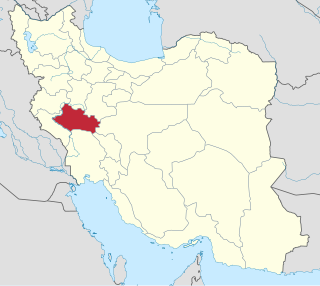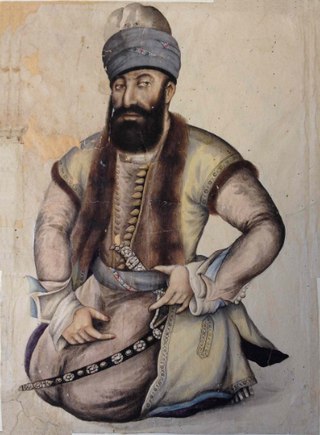Related Research Articles

Lorestan province is one of the 31 provinces of Iran. Its capital is the city of Khorramabad.

Mohammad Karim Khan Zand was the founder of the Zand dynasty, ruling from 1751 to 1779. He ruled all of Iran (Persia) except for Khorasan. He also ruled over some of the Caucasian lands and occupied Basra for some years.

The Zand dynasty was an Iranian dynasty, founded by Karim Khan Zand that initially ruled southern and central Iran in the 18th century. It later quickly came to expand to include much of the rest of contemporary Iran as well as parts of Iraq. The lands of present-day Armenia, Azerbaijan, and Georgia were controlled by khanates which were de jure part of the Zand realm, but the region was de facto autonomous. The island of Bahrain was also held for the Zands by the autonomous Al-Mazkur sheikhdom of Bushire.
Lak is a Kurdish tribe native to Western Iran. They speak Laki, which is considered a Kurdish dialect by most linguists.
The Zand tribe is a Laki-speaking Kurdish tribe mainly populating the countryside of Khanaqin in Iraq and in the provinces of Kurdistan and Hamadan of Iran.
Ardalan was a hereditary Kurdish vassaldom in western Iran from around the 14th century until 1865 or 1868 with Sanandaj as capital. The territory corresponded roughly to present-day Kurdistan Province of Iran and the rulers were loyal to the Qajar Empire. Baban was its main rival. Gorani was the literary language and lingua franca. When the vassaldom fell, literary work in Gorani ceased.

Sadeq Khan Zand, also known as Mohammad Sadeq, was the fourth Shah of the Zand dynasty of Iran from August 22, 1779 until March 14, 1781.

The Shaki Khanate was a khanate under Iranian and later Russian suzerainty, which controlled the town of Shaki and its surroundings, now located in present-day Azerbaijan.

The Nakhichevan Khanate was a khanate under Iranian suzerainty, which controlled the city of Nakhichevan and its surroundings from 1747 to 1828.

Ali-qoli Khan, commonly known by his regnal title Adel Shah was the second shah of Afsharid Iran, ruling from 1747 to 1748. He was the nephew and successor of Nader Shah, the founder of the Afsharid dynasty.
The Donboli are a Turkic-speaking Kurdish tribe who live around Khoy and Salmas in northwestern Iran. They are currently adherents of Shia Islam, but before that they were reportedly Yazidis for a long time.
The Khorshidi dynasty, Abbasi dynasty or Shahs of Little Lorestan (1184–1597) was a Lur dynasty that ruled Little Lorestan in the later Middle Ages from their capital Khorramabad.
Fath-Ali Khan Afshar, was a chieftain from the Afshar tribe of Urmia, and one of the four contenders for supremacy in Iran between 1751–1763. He was ultimately defeated and captured in February 1763 by one of the contenders, the Zand ruler Karim Khan Zand. The latter had Fath-Ali Khan executed the following year, in July 1764.
Zaki Khan Zand was an Iranian military commander and contender for the throne. A member of the Zand dynasty of Iran, Zaki Khan, though he never became the ruler of Iran, managed to exert power over the country during the three months between the death of his half-brother Karim Khan, on March 2, 1779, and his own brutal death.

The Tabriz Khanate was a Caucasian Khanate from 1757 to 1799, centered around Tabriz and led by members of the Turkified Kurdish Donboli tribe.

Abu Torab, better known by his dynastic name of Ismail III (اسماعیل), was a Safavid prince, who reigned as a figurehead under the authority of Ali Mardan Khan Bakhtiari briefly from 1750 to 1751, and then under the Zand ruler Karim Khan Zand from 1751 till his death in 1773.
Ali Mardan Khan Bakhtiari was the Bakhtiari supreme chieftain (ilkhani) of the Chahar Lang branch, and major contender for supremacy in western Iran after the death of Nader Shah in 1747.
The province of Lorestan was a western province of Safavid Iran, corresponding to the present-day provinces of Ilam and Lorestan. It was one of the five velayats of the country, and was thus ruled by a vali.
Shahverdi Abbasi was the last Khorshidi Lur hakem (governor) of Lorestan from 1593 to 1598, with a one year interruption. He had succeeded his father Soltan Mohammad Shah and soon rebelled against his suzerain Shah Abbas I, who subsequently marched towards him. Shahverdi fled and his nephew Soltan Hoseyn ibn Shah Rostam was appointed governor of Lorestan in his stead, with the exception of Khorramabad, which was given to Mehdiqoli Khan Shamlu. Shahverdi returned the next year and killed Soltan Hoseyn, thus restoring his rule in most of Lorestan. In 1595, the Safavids returned Khorramabad to him. Shahverdi soon staged another rebellion, but was defeated and executed by Shah Abbas in 1598. The latter subsequently had all male members of the Khorshidi family either blinded or jailed, thus marking their end.
Hoseyn Khan ibn Mansur Beg Solvizi was initially the Lur hakem (governor) of parts of Lorestan from 1593, and then later beglerbeg of the whole province. He also served as the mir of the Bakhtiaris. From 1603 and onwards, the Solvizi family became the hereditary governors of Lorestan. Hoseyn Khan was succeeded by his son Shahverdi Khan in 1631.
References
- 1 2 3 4 5 Oberling 1999.
- ↑ Minorsky 1986, pp. 829–832.
- ↑ Floor 2008, p. 236.